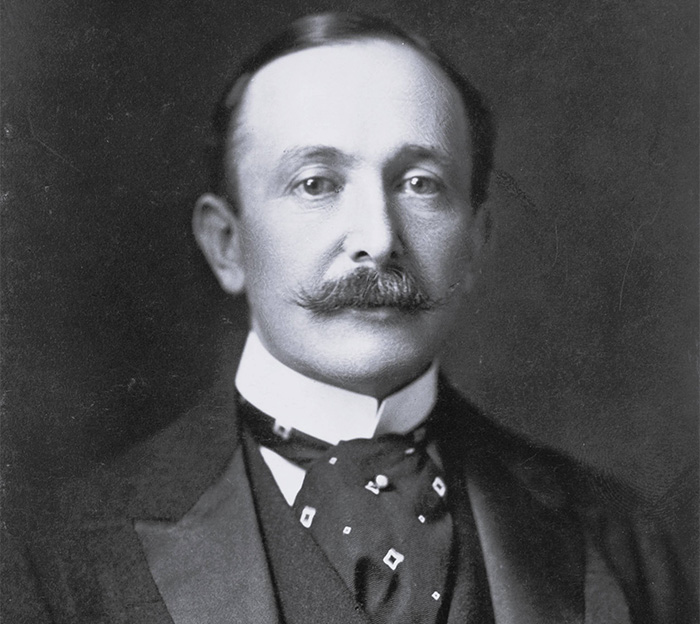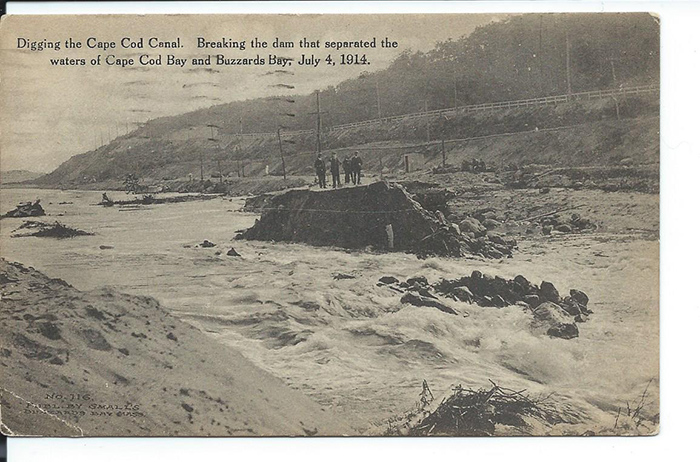Advertisement
Learn about the twists and turns, false starts, and abandoned efforts behind how Cape Cod Canal came to be.

A 1922 map of the Cape Cod Canal showing bridges, mooring points, and other features Public domain, via Wikimedia Commons
The idea of a water connection between Cape Cod and Buzzards Bay is 400 years old in 2023. It was first proposed in 1623 by Myles Standish, the military commander of the Plymouth Colony. Its location was obvious even then: in the isthmus valley between the mainland and the cape, where the Manomet River led south into Buzzards Bay and the Scusset River led north into Cape Cod Bay, later to be dug out by the canal.
The relatively short land portage between these rivers is where the Pilgrims chose to build their Aptucxet Trading Post in 1627 to barter with the Dutch and Native Americans. Dutch traders would sail up from what is now New York into the Manomet, while the Pilgrims would sail down from Plymouth into the Scusset, and trade at the land bridge at Aptucxet. Commerce, convenience, and safety were why the site was selected.

The British bark Kate Harding wrecked November 30, 1892, on Nauset Beach in Orleans, Massachusetts, on the Outer Shore of Cape Cod, during a fierce storm. Photo: New England Historical Society
Humanitarian reasons for digging a canal there would be added in later years, as commerce grew and countless ships and lives were lost while trying to navigate the treacherous and often foggy shoals of outer Cape Cod. More than 1,000 shipwrecks lie in the Atlantic breakers between the towns of Truro and Wellfleet on the arm of the cape. In the late 1800s, Cape Cod claimed a ship roughly every two weeks.
Official governmental interest in a canal began in 1697 with consideration of proposals, but no action was taken. Over the next two centuries, numerous surveys, recommendations, and false starts would be made.
Compared with other famous canals of the era, Cape Cod’s came late in the game. Even during the heyday of canal building – the Erie Canal opened in 1825, the Suez Canal in 1869, and work on the Panama Canal began in 1881 – serious work on a canal for Cape Cod wouldn’t begin until 1909. Why the long delay?
Robert Farson, in his excellent history of the project, “The Cape Cod Canal,” says it was “probably that the motivation for building other canals was primarily commercial, while the principal reason for a Cape Cod canal was humanitarian – to save lives.”
Without government sponsorship, the staggering toll of shipwrecks and death didn’t matter unless the canal could turn a profit. Much of this article is based on information from Farson’s book.

August Belmont in 1890. Photo: Pach Brothers, Public domain, via Wikimedia Commons
Belmont’s Stake
The key person who saw profit in the canal and finally got it built was August Perry Belmont, the son of a private European banker and financier who became a titan of American capitalism. He helped financed the national railroad system, built part of New York City’s subway, played a role in getting American aviation off the ground, founded the American Kennel Club, and got two victorious America’s Cup yachts built. He is typically associated with one of his lesser accomplishments, building the Belmont Park horseracing track on Long Island.
To the Cape Cod Canal project, Belmont brought vast wealth, deep knowledge of transportation, and three critical players: visionary civil engineer William Barclay Parsons (who helped build the Panama Canal), Michael J. Degnon (a chief contractor for the New York subway), and DeWitt Clinton Flanagan (a shrewd financial guru). This team would line up the rights, property, cash, and logistics to finally make the canal a reality.
Soon after serious work began in 1909, excavators ran into serious delays from the many glacial boulders that had to be blasted out of the way. To make up time, Belmont and his engineers brought in a fleet of powerful hydraulic dredges (which dug in the waters at both ends of the canal) and steam-powered shovels to excavate “in the dry” on the land between the two bays, working in carefully dammed sections of the ditch. Electric pumps removed water from the cut, which was 20 feet below groundwater and 10 feet below sea level in places.

The Gov. Warfield dredge digging the canal in 1914. Photo: From a 1914 postcard; Public domain, via Wikimedia Commons

Breaking the dam that separated the waters of Cape Cod Bay and Buzzards Bay on July 4, 1914. Photo: Public domain, via Wikimedia Commons
By the spring of 1914 there was just one remaining dam between the two bays, known as “Foley’s Dyke.” A ceremonial “blending of the waters” through the barrier was held April 21, but the real opening came on July 4, when workers fully opened the channel. High tide from Cape Cod Bay violently rushed through, ripping a big gash in the earthen dam and sending powerful, flood-like waters pounding into Buzzards Bay.
After three more weeks of frantic dredging, the formal opening of the canal was held July 29, 1914. A gleaming flotilla of passenger ferries, naval destroyers, private yachts, and other vessels started their grand procession out of Buzzards Bay and into the canal. Dredges, tugboats, scows, and the rest of work fleet were anchored or tied up nearby and decked out in flags and streamers. With all ships blasting their steam whistles and crowds cheering ashore, it was a festive and noisy scene. Upon reaching the eastern end of the canal, the many celebrities were offloaded to Sandwich for speeches, while the Parade of Ships turned around in Cape Cod Bay and returned to Buzzards Bay. The first toll, early the next day, was a small private yacht that paid $8 to transit the canal. That’s equivalent to about $244 today!
The Feds Step In
Despite expectations, shipping through the canal was far less than expected. Tolls were a disincentive, and many skippers feared the strong currents (which could reach 6 knots in the narrow channel) and risk of colliding with a bridge. Only 15 feet deep at low water, the original canal was too shallow for loaded deep-draft coal barges (the primary source of expected income) and too narrow for two-way passages. Ground fog, usually occurring around Bournedale, often stopped traffic and led to accidents that closed the canal.
The worst, in 1916, involved the S.S. Bayport, which veered out of the channel and struck the bank. When pulled free by tugboats, it quickly sank and shut down the canal for three months – until the wreck was scuttled by explosives. During World War II, a fully loaded coal ship, the SS Stephen R. Jones, was pushed out of the channel by wind and currents and hit the north bank of the canal near the Bourne Bridge, sinking by the bow. It, too, was removed by dynamite, closing the canal for more than a month.
Hemorrhaging money, Belmont began to explore a government takeover of the canal only a year after it opened, leading to tortuous negotiations and condemnation proceedings by the U.S. government. German submarines patrolling off New England during World War I spurred military interest in the canal, especially after U-156 attacked a tugboat off Chatham (near the elbow of Cape Cod) in 1918, sinking its three coal barges and gutting the tug.
Ultimately, Congress approved $11.4 million to buy the canal, and Uncle Sam took over in 1928. With tolls eliminated, shipping traffic skyrocketed, and the Army Corps of Engineers started the long and expensive process of building higher fixed roadway spans (both opened in 1935) and widening and deepening the canal to its current dimensions. The vertical-lift Cape Cod Canal Railroad Bridge, with its 544-foot horizontal span, was the longest lift span in the world when it was built in the early 1930s.
By the late ’30s, the expanded canal started seeing a surge in British and American warship and freighter traffic as preparations began for World War II. Buzzards Bay, in particular – soon ringed with antisubmarine mines – became a crowded anchorage filled with ships staging for trans-Atlantic convoys to Britain. Special care was given to the “hot tows” – Navy barges filled with high explosives, shells, and bombs.
A Pre-War Cover-Up
Four months before the 1941 attack on Pearl Harbor, the Cape Cod Canal played an important role in the crucial – and top-secret – six-day meeting in Newfoundland, Canada, between President Franklin Roosevelt and British Prime Minister Winston Churchill. This was their first face-to-face encounter, resolved many issues of American wartime aid to Britain, and resulted in the Atlantic Charter, which ultimately led to the creation of the United Nations and the post-war world order.
To keep the meeting secret, Roosevelt left on what appeared to be a pleasure cruise Down East on the presidential yacht Potomac out of New London, Connecticut. But off Martha’s Vineyard, Roosevelt was stealthily transferred to a Navy cruiser and sped north to Canada, while the Potomac turned back for Buzzards Bay. With three sailors disguised to look like Roosevelt, his press secretary, and his top military aide, the yacht entered the canal and leisurely headed east into Cape Cod Bay, the actors sitting outside on the stern deck where they were readily visible. FDR’s presence in the canal was quickly noted and duly reported.
The cover-up in the Cape Cod Canal successfully threw German spies off the scent at a crucial moment just before America entered the war.
